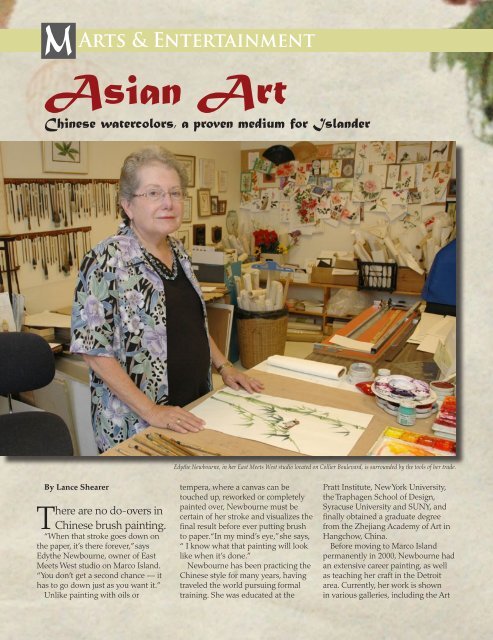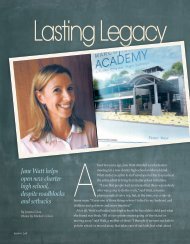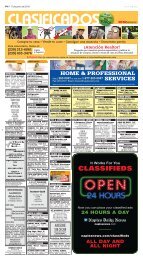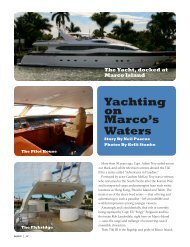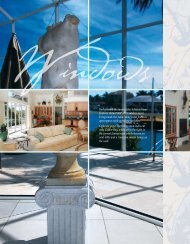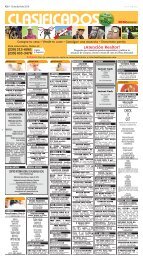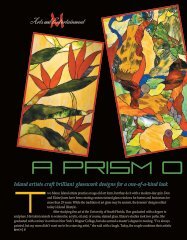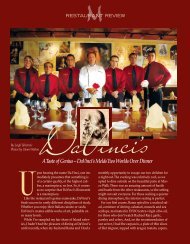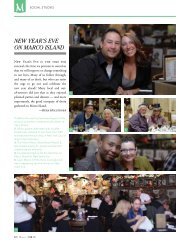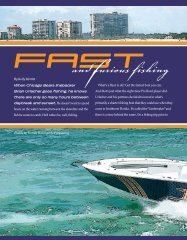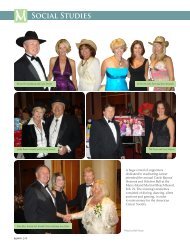Asian Art - Naples Daily News
Asian Art - Naples Daily News
Asian Art - Naples Daily News
Create successful ePaper yourself
Turn your PDF publications into a flip-book with our unique Google optimized e-Paper software.
M <strong>Art</strong>s<br />
& Entertainment<br />
<strong>Asian</strong> <strong>Art</strong><br />
Chinese watercolors, a proven medium for Islander<br />
Edythe Newbourne, in her East Meets West studio located on Collier Boulevard, is surrounded by the tools of her trade.<br />
By Lance Shearer<br />
There are no do-overs in<br />
Chinese brush painting.<br />
“When that stroke goes down on<br />
the paper, it’s there forever,” says<br />
Edythe Newbourne, owner of East<br />
Meets West studio on Marco Island.<br />
“You don’t get a second chance — it<br />
has to go down just as you want it.”<br />
Unlike painting with oils or<br />
tempera, where a canvas can be<br />
touched up, reworked or completely<br />
painted over, Newbourne must be<br />
certain of her stroke and visualizes the<br />
final result before ever putting brush<br />
to paper. “In my mind’s eye,” she says,<br />
“ I know what that painting will look<br />
like when it’s done.”<br />
Newbourne has been practicing the<br />
Chinese style for many years, having<br />
traveled the world pursuing formal<br />
training. She was educated at the<br />
Pratt Institute, New York University,<br />
the Traphagen School of Design,<br />
Syracuse University and SUNY, and<br />
finally obtained a graduate degree<br />
from the Zhejiang Academy of <strong>Art</strong> in<br />
Hangchow, China.<br />
Before moving to Marco Island<br />
permanently in 2000, Newbourne had<br />
an extensive career painting, as well<br />
as teaching her craft in the Detroit<br />
area. Currently, her work is shown<br />
in various galleries, including the <strong>Art</strong><br />
MARCO | 43
Edythe Newbourne personalizes a painting in<br />
the Chinese manner with her own unique chop.<br />
landscapes and whimsical paintings of<br />
fish, frogs and fruit.<br />
Interpreting the same subject<br />
matter in various media affords her a<br />
comfort level with those concepts and<br />
materials. This allows Newbourne to<br />
work quickly, and, to an untrained eye,<br />
effortlessly.<br />
“I have painted bamboo and birds so<br />
much, they just flow,” says Newbourne,<br />
who can complete a watercolor of a<br />
familiar theme in less than 30 minutes,<br />
although a new concept can take a<br />
week of contemplation and planning.<br />
“It’s not that I don’t sketch, but by the<br />
time I paint, it’s all in my mind.”<br />
Newbourne’s process seems simple<br />
to a casual observer. With a piece of<br />
rice paper, she pauses just a moment<br />
and picks up a brush from her vast<br />
assortment. In minutes, bamboo<br />
branches grow on the paper and a<br />
brown-winged bird appears, perched<br />
League, Marco Island Center for the<br />
<strong>Art</strong>s. Newbourne’s own studio features<br />
a selection of framed paintings<br />
hanging on the walls, but she only<br />
shows her work by appointment.<br />
She also sells packs of original handpainted<br />
note cards.<br />
In addition to creating her own<br />
artwork, Newbourne teaches Oriental<br />
painting at the <strong>Art</strong> League, where she<br />
is education chairman and teaches<br />
too; her next class will be in 2010. She<br />
also conducts workshops at BIGarts on<br />
Sanibel.<br />
“I like to work with a small group,<br />
no more than 10 or 12 students at the<br />
most,” she says. “I demonstrate the<br />
technique we’re working on, and then<br />
work with each student individually.<br />
It’s very hands-on.”<br />
Oriental brush painting, she stresses,<br />
is art of the mind. “I’m painting my<br />
concept — it’s not a portrait. I may<br />
have flowers in front of me when<br />
I paint, but I’m not painting that<br />
particular flower.”<br />
Newbourne prefers to paint on rice<br />
paper for its great ability to absorb<br />
pigment, moreso than hard-finished<br />
Western watercolor paper, and she<br />
also paints on silk. Some recurring<br />
motifs in her work include blossoms,<br />
birds and bamboo — the classics of<br />
Chinese art, along with non-traditional<br />
MARCO | 44<br />
Rice paper, like what was used for this painting of peonies, can actually be rice, cotton or hemp-based.
on a slender stalk. With black<br />
sumi ink, Newbourne adds detail<br />
to the green leaves, as well as<br />
giving the bird’s beak a bright<br />
splash of yellow with another ink.<br />
“I know sparrows don’t have<br />
yellow beaks,” she laughs, “but<br />
gray beaks are so dull.”<br />
Back at her worktable, the new<br />
painting is finished, Chinesestyle,<br />
by adding the artist’s “chop,”<br />
or stamp, pressed onto the paper<br />
with red ink. Newbourne has<br />
something like a dozen chops<br />
she uses and, in keeping with<br />
tradition, the Chinese characters<br />
spell out her name. In her case,<br />
the words translate literally as a<br />
baby, or “new born.”<br />
Once she’s done pressing<br />
the stamp to the paper, she<br />
takes a pencil and signs her<br />
name, lowercase, in English:<br />
e t newbourne. After all, she<br />
says, “I’m not Chinese — I’m<br />
American.” M<br />
Edythe Newbourne lays down the<br />
first strokes of a painting she has<br />
already finished in her mind’s eye.<br />
MARCO | 45


